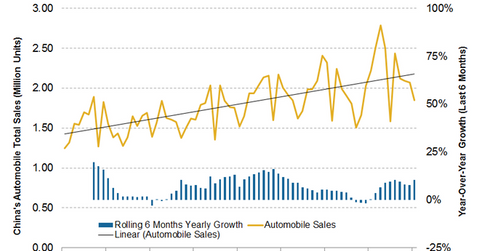The Outlook for China’s Automobile Sales and Why It Matters
China’s passenger car sales rose 26% year-over-year in August. This is the fourth consecutive month that car sales have risen in the double digits.
Oct. 4 2016, Updated 8:04 a.m. ET

China’s automobile sales
The automotive industry is the second-largest steel consumer after the real estate sector. In this part of the series, we’ll look at the recent trend in the Chinese automotive industry.
Car sales rise
China’s passenger car sales rose 26% year-over-year in August. This is the fourth consecutive month that car sales have risen in the double digits. Higher automotive sales in the world’s largest car market seem to bode well for global steel demand.
This also supports seaborne iron ore players such as BHP Billiton (BHP), Rio Tinto (RIO), and Vale SA (VALE). ArcelorMittal (MT) is the leading steel supplier for the automotive sector. AK Steel (AKS) is another major supplier for US automotive companies.
Outlook
On September 30, 2015, China announced a 50% cut in its sales tax on cars with engines smaller than 1.6 liters. This tax cut will be effective until the end of 2016. Its expiration could lead to stalling growth in 2017 and beyond. Some analysts expect China to extend the tax cut to the next year. If the tax cut is not extended, we could see some moderation in the country’s car sales.
Stalled growth would have a negative effect on steelmakers and ultimately on iron ore producers such as Rio Tinto (RIO), BHP Billiton (BHP) (BBL), Vale SA (VALE), and Cliffs Natural Resources (CLF).
The SPDR S&P Global Natural Resources ETF (GNR) tracks the natural resources index. Rio Tinto forms 1.8% of its holdings.
In the next part of our series, we’ll see whether credit-fueled property growth is sustainable in China.
